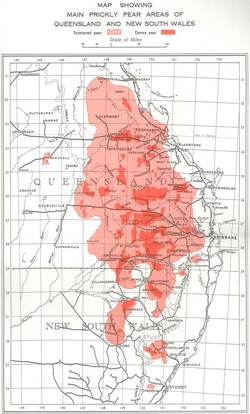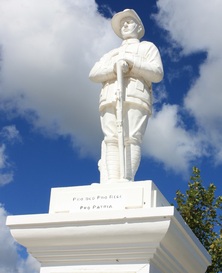 Source: A P Dodd, 1940. Source: A P Dodd, 1940. During the 1920s, the biggest concern for many people in country Queensland, aside from the weather, was the rapid spread of the pest cacti commonly known as prickly pear. From Mackay in central Queensland to central New South Wales, these plants were multiplying and choking the land. They had been introduced into Australia from North and South America during the nineteenth century. Warnings of their capacity to multiply and make good land useless began in the 1870s, but it wasn't until the 1890s that bylaws and legislation requiring their removal were created. By the early twentieth century, the need for a biological control of the pest had been recognised. Although an effective poison to kill the cacti was determined in 1916, obtaining it during World War One was difficult and Australia's manpower and the money to control prickly pear were employed overseas. Finally, in 1919, the Commonwealth Government and the governments of Queensland and New South Wales established a joint project, to discover and introduce into Australia biological pests of prickly pear, to control its spread. Achieving this goal was to take 10-20 years, but the introduction of Cactoblastis cactorum and a number of other parasites of the cacti, was an outstanding success. Not all of Queensland was affected by prickly pear. Open plains were generally spared the infestation - among them the plains of western Queensland. It is here that my latest book, All Quiet on the Western Plains is set. The characters therefore weren't involved in the struggle to control prickly pear that was going on in much of rural Queensland in 1924. Does your family have a story from the bad old days of Prickly Pear? I would love to hear from you. All Quiet on the Western Plains - available 1 May 2014 - from Amazon, Steam eReads and Book Srand. References: Dodd Alan P. The progress of biological control of prickly pear in Australia. Commonwealth Prickly Pear Board, Brisbane, 1929. Dodd Alan P. The biological campaign against prickly-pear. Commonwealth Prickly Pear Board, Brisbane, 1940. Dodd, Alan P. ‘The Conquest of Prickly-Pear’. RHSQJ, 1945, 3, 5, pp. 351-61. Mann, John. The Naturalised Cacti in Australia, Queensland Lands Department, Brisbane, 1970.
5 Comments
 WWI memorial, Crows Nest, Qld. WWI memorial, Crows Nest, Qld. With the hundredth anniversary of the start of World War One approaching, I have been reading lots of autobiographies and biographies of soldiers and nurses who served in Europe and the Middle-East. A few months ago all this reading sparked the idea for my forthcoming novella, All Quiet on the Western Plains. English nurse Fleur Armitage wants to escape all reminders of the Great War, which killed family, friends and patients - by living as far from its reminders as possible - in outback Queensland, Australia. Jack Edgarson is a war hero, pastoralist and damaged man. Suffering from nightmares and sleep walking, he fears he may harm someone, so lives in isolation. Through a chance meeting, their lives become entangled. They come to share a love of the wide western plains, but dare they love each other? For some World War One autobiographies and biographies, see my sources page on this website. All Quiet on the Western Plains – available 1 May 2014 – from Steam eReads and Amazon. |
Archives
June 2024
Categories
All
|
 RSS Feed
RSS Feed